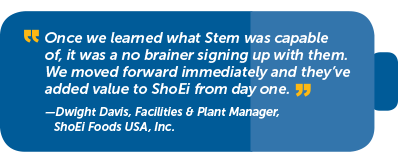ShoEi Foods USA, Inc. operates a major food processing operation. Nearly 1,000 acres of prunes and walnuts are handled annually at the Olivehurst, California facilityy. In addition to its processing plant, the business requires energy intensive refrigerated warehouses that operate around-the-clock.
Knowing that improved energy management would directly impact the bottom line, as well as underscore the company’s commitment to sustainability, ShoEi’s executive team began a search for the best solutions to reduce energy use. They originally looked to solar, and engaged Cenergy Power after a competitive solicitation. When Cenergy Power saw ShoEi’s energy profile they knew a combined solar-storage solution would help ShoEi save more than solar alone.
A Creative Approach to Access Lower Rates
Cenergy partnered with Stem to scope out a combined solar-storage energy management system for ShoEi. As Stem’s team of energy consultants reviewed the company’s energy profile, they identified a lucrative opportunity for ShoEi to apply Stem’s software plus storage solution to modify their energy profile and qualify for a more cost-effective rate plan.
For businesses, electric bills include two main components: energy charges, based on the total amount of energy used during the month, and demand charges, which are based on the maximum amount of energy used at any one time during the month. Businesses that can consistently keep their maximum demand under a certain level, decreasing their energy provider’s cost to serve them, can switch to a more advantageous rate plan. By integrating solar to offset daytime energy use and storage to lower demand charges and stay under the specified limit, ShoEi would save an estimated $6,000 per month.
Stem proposed the rate switch plan to ShoEi, and shortly after, Stem and Cenergy Power were awarded the project.
Software & Storage: An Effective Line of Defense
In order to move to the preferable rate class, ShoEi would have to stay below the qualifying maximum demand level of 500kW for one full year. Stem’s real-time software added a level of precision to ShoEi’s operations that proved critical to maintaining consistent control over energy usage.
“Real-time is key, especially when every 15-minute interval counts. If you have one 15-minute interval in a month that exceeds maximum demand for your current rate, it’s a strike against you. If you get three strikes in consecutive months,  you’re back up to the higher rate immediately,” said Dwight Davis, ShoEi Foods USA’s facility and plant manager.
you’re back up to the higher rate immediately,” said Dwight Davis, ShoEi Foods USA’s facility and plant manager.
To begin integrating its energy management technology into ShoEi’s daily operations, Stem first activated its software to help ShoEi gain better visibility into the facility’s energy usage. The software enabled ShoEi to understand the energy impacts of specific equipment, identify patterns, and make adjustments to smooth usage peaks throughout the day.
Next, Stem installed its storage system. The software and battery work in concert to lower ShoEi’s maximum demand: when the software detected a spike in energy usage that would cause ShoEi to exceed the 500kW demand threshold, it automatically sent a text message notifying ShoEi facility managers, who could then choose to reconfigure operations and reduce demand. Concurrently, Stem’s storage units automatically released stored energy, which bought more time for the team to make the necessary adjustments.
A Complex Cost Reduction Strategy Made Simple
With precise planning and close cooperation with Stem’s team of energy consultants, ShoEi was able to switch to a more cost-effective rate in the minimum possible time— one year.
“We told Stem what we wanted to achieve and they made it happen: Stem’s software collected the data that was needed to make a plan precise enough to hit our goal. When we finally cleared the mark and moved down to the lower rate, we actually jumped for joy. Now we save about $6,000 per month as a result,” said Mr. Davis.
“Stem’s storage acts as a first line of defense,” said Mr. Davis. “It gives us time to make adjustments that ultimately make or break ou r ability to meet the requirements for the lower rate.” The Stem system automatically produces savings and also provides ShoEi’s team with valuable insight into its energy data.
“Now that we understand our energy patterns, I don’t feel like I have to monitor the system every day to know that our energy usage is in check. I try to look at least once a week, though I don’t normally need to.” Mr. Davis commented.
Persistent Savings Despite Facility Expansion
A few months after successfully switching to the new rate class, ShoEi made large-scale facility upgrades to increase their overall throughput and increased their horsepower by more than 50 percent, threatening to push them over the 500kW limit. Stem worked closely with ShoEi to refine the system and help them optimize operations to stay below the threshold, despite the near doubling of energy flowing through the facility. With Stem’s software and storage as a safety net, ShoEi has successfully maintained its current rate tier without a single misstep.
“Stem was up for the challenge. They’re problem solvers and we knew they could make the rate switch work for us even with the new facility. We had confidence in the people, and in the software. Not just any energy management software could do this, but we knew Stem’s could. This scenario proves that with Stem’s technology, you can do more with less,” said Mr. Davis.
For more information, please visit:
www.stem.com.










